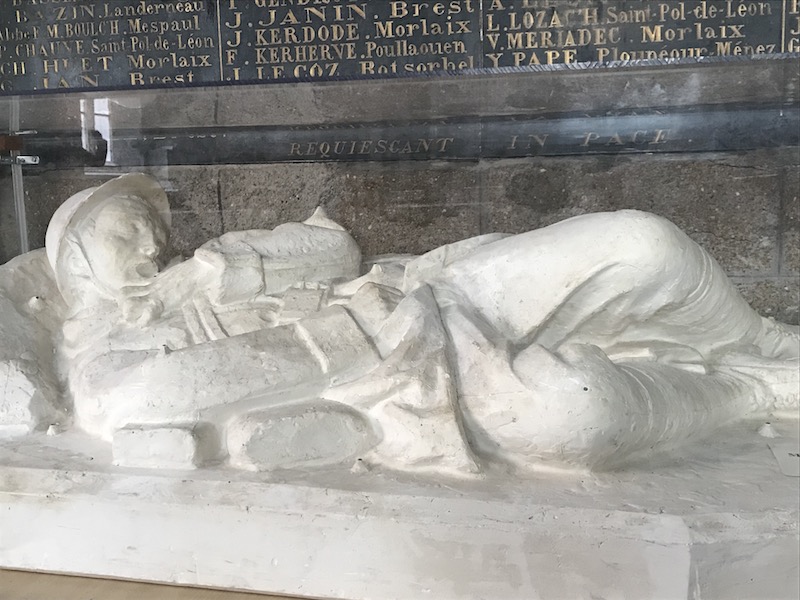Our Blog - Bretagne Trip - Summer 2021 - Saint-Pol-de-Léon, France
We had never heard of Saint-Pol-de-Léon until we drove through the town on our way to Roscoff. Another old town, there are some vestiges that would demonstrate a prehistoric population as well as a Roman military presence in the 3rd century. Based on ancient writings, Saint Pol would have then been enclosed by extraordinary high moated walls. Starting in the 6th century, it became a religious center with a new episcopal house and seminary. During the French Revolution the city lost their religious status which started 100 years of economical decline. In 1847, the French novelist Gustave Flaubert say that "Today Saint Pol de Léon is a dead city". Mind you ... the census in 1846 showed almost 7,000 inhabitants, which is just slightly higher than what it was in 2017 (just shy of 6,600 people).
The name comes from the patron saint, Saint Paul Aurelian, known in the Breton language as Saint Pol de Léon. He was a 6th-century Welshman who became first bishop of the See of Léon and one of the seven founding saints of Brittany. He allegedly died in the year 575, rumored to have lived to the age of 140.
It is the largest vegetable producer and farmers market in Brittany responsible for 90% of French artichoke production and exports tens of thousands of vegetables to the whole of Europe every year. We don't have many pictures of the town, but focused on the two churches in town, along with a fountain/wash-house.
The Cathedral Saint-Paul-Aurelien was the seat of the diocese of Leon from the 6th century until it was abolished in 1801. This is the 3rd Cathedral building (the other 2 were destroyed or damaged) and the construction started in 1230 and lasted until 1539. None of the stained-glass dates from that time as a lightning strike in 1601 caused all of the windows to shatter. It is a Gothic church with Norman influences. There are a couple places where you can get a glimpse of the previous Romanesque church, but we didn't really see much of it. This front façade with the two tall spires was made from limestone imported from Normandy. The choir and transept was done later, in the 15th century, and are made of local granite. There are three bells which date from more than three centuries ago, including the oldest bourden bell in Brittany, which weighs more than 2 tons and was cast in 1563.



Here you can see the nave of the church, with the very high ceiling and gothic arches separating the nave from the side aisles. I thought the arches on the middle tier was particularly interesting, as it has two larger arches in the middle with 2 narrower arches on the sides ... why not just have 3 of the same width?
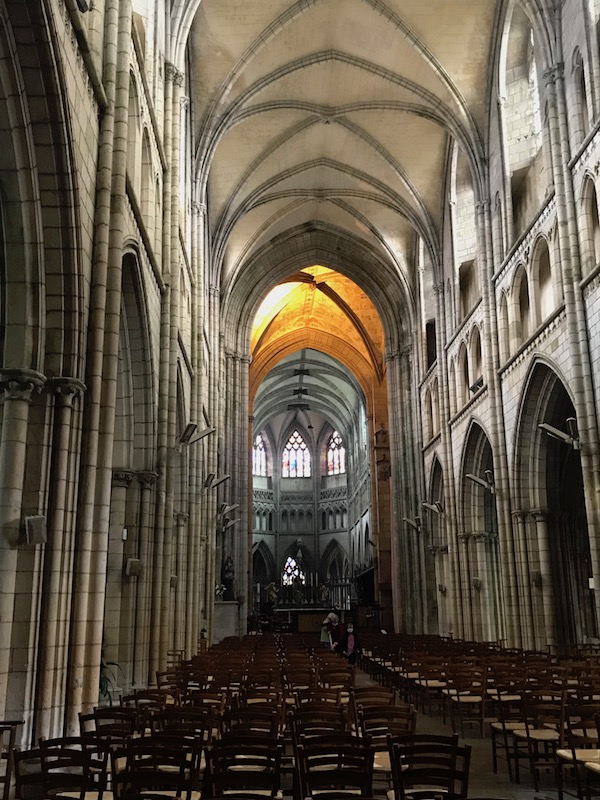
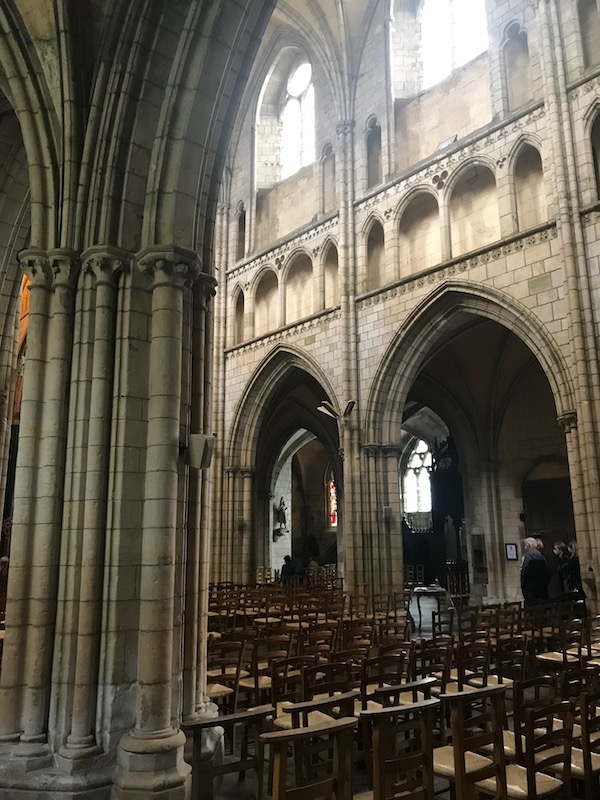
The granite baptismal font has a really nice wooden canopy carved out of oak. It was done in a local studio in 1897.



This is a fresco depicting the Last Judgement, done in 1897.
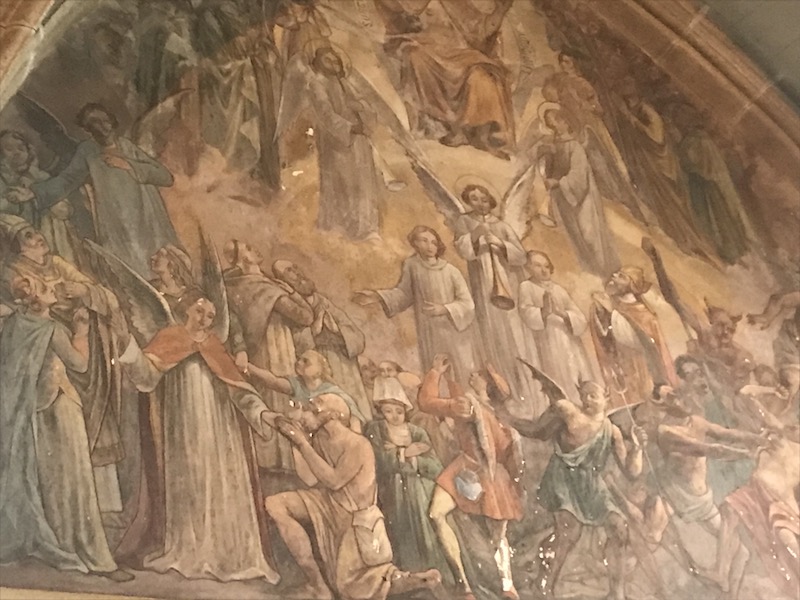
There were lots of very nice stained glass windows, dating from different periods, although I only picked a few to show in the blog. The first was in the baptistery and was entitled "Les œuvres de miséricorde". This window dates to 1560 and is one of the oldest in the cathedral. It deals with the good works (Les œuvres) of the church (miséricorde means mercy). It has 4 main panels which show healing of the sick, feeding the hungry, welcoming travelers, and freeing captives (I've shown each in detail in order).
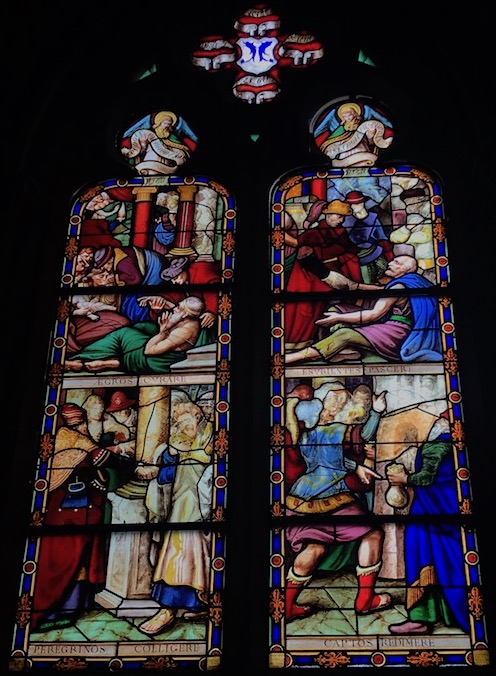

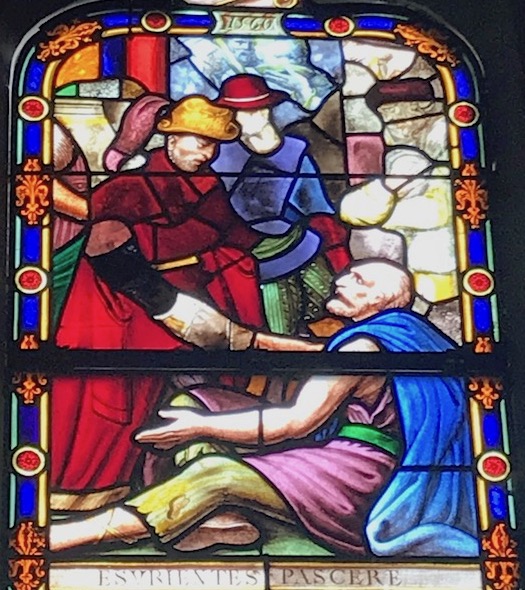
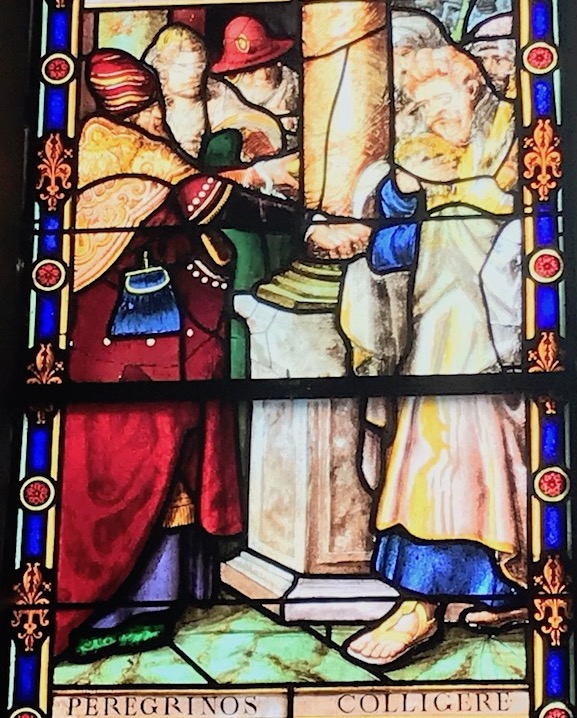
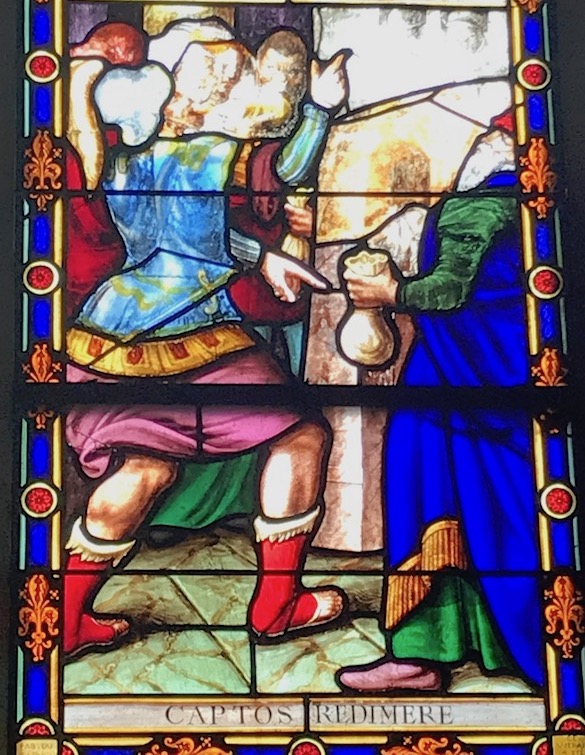
The rose window comes from a workshop in Tours and was done in 1873. In the middle of the rose is the "Holy Trinity" surrounded in the next ring with 8 angels playing various musical instruments. The ring outside of that is 16 prophets, martyrs and saints either singing or playing instruments. The 6 panels at the base of the window depict, (left to right) Judas' kiss of betrayal, Jesus in front of Pontius Pilate, Jesus being mocked, Jesus on the journey to Calvary, the crucifixion and the descent from the cross.
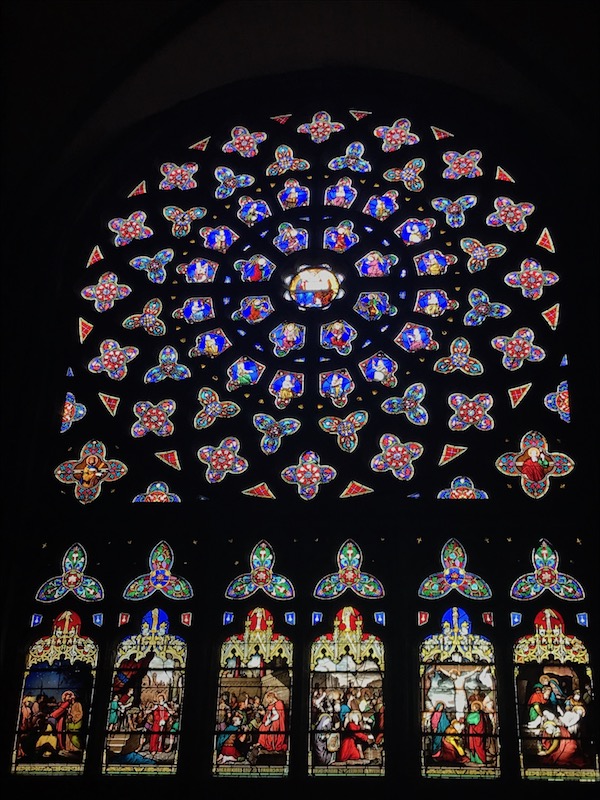
This window was in the Saint-Roch chapel. The middle pane depicts the "Last Judgement" with Saint Michael looks down on the fires of Hell. The left and right panes depict one of the donors of the church, Jean le Scaff (in the left pane with John the Baptist) and his wife, Anne du Bois (in the right pane, John the Evangelist is holding a chalice and presenting the wife to Saint Anne).
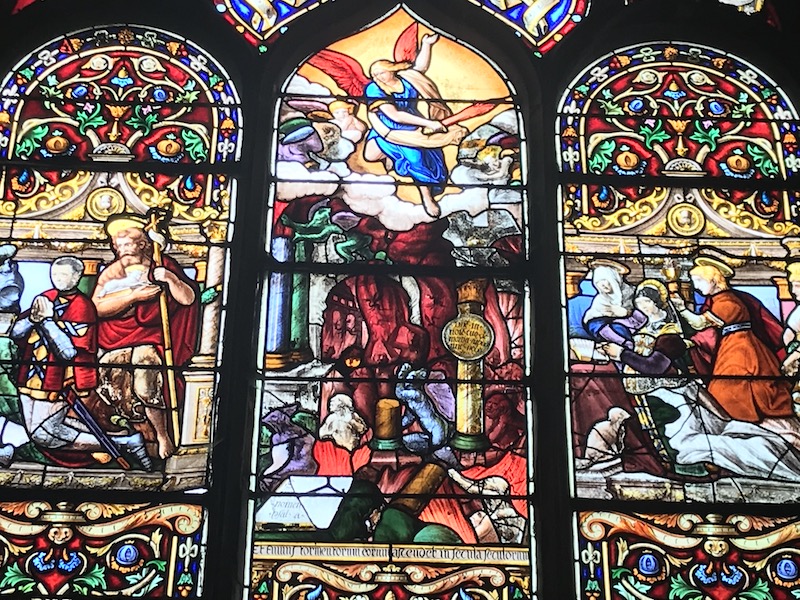
The choir stalls are of carved oak and date from the 16th century. Carved from black Mouroux marble, the altar was created in 1746. The altar is surrounded by two angels and has a ciborium (a canopy) which hangs above it. It is a carved wooden replica of a palm tree symbolizing "Victory" and the "Resurrection". This palm tree is between 5 and 6 meters high and is richly decorated with wheat ears, vine leaves and grapes. The palm tree dates to around 1820 to 1823. There are three similar ciboriums in France (Amiens, Reims and Saint-Germain).
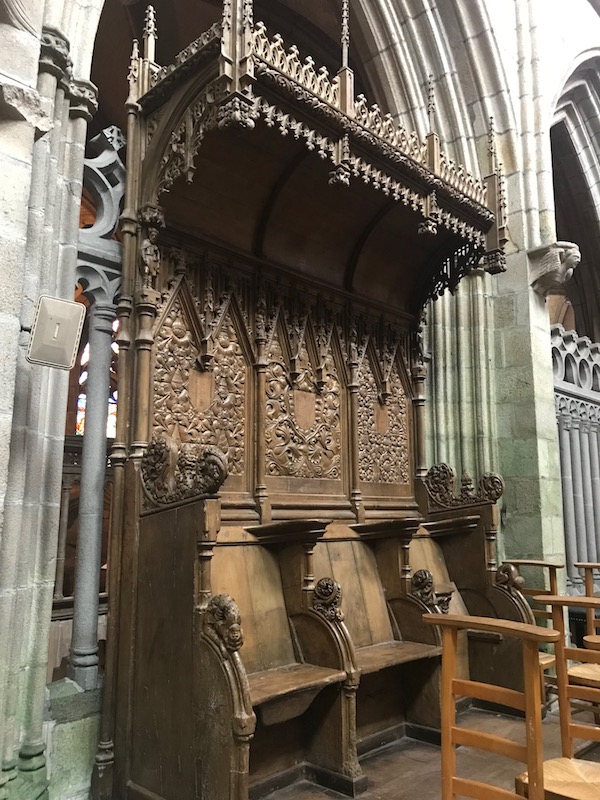

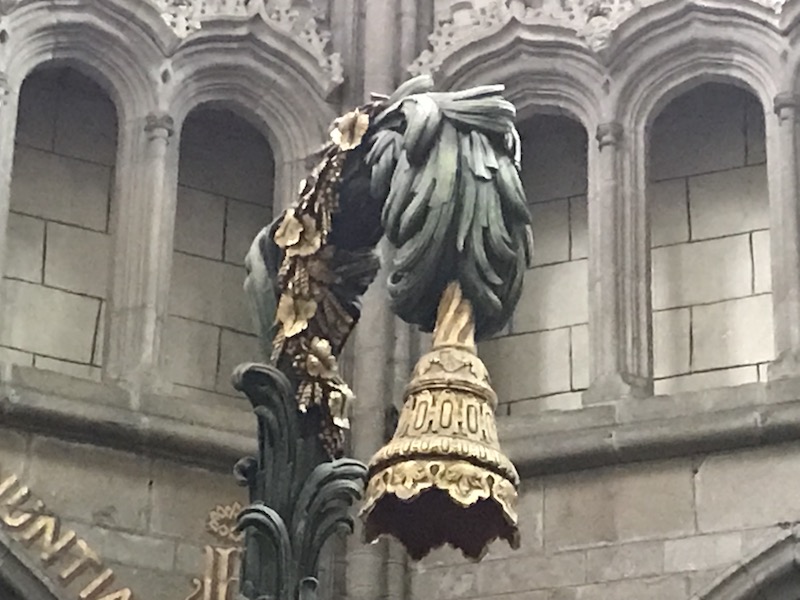
I don't have exactly what chapel this was in, but I though the ceiling painting was quite nice.
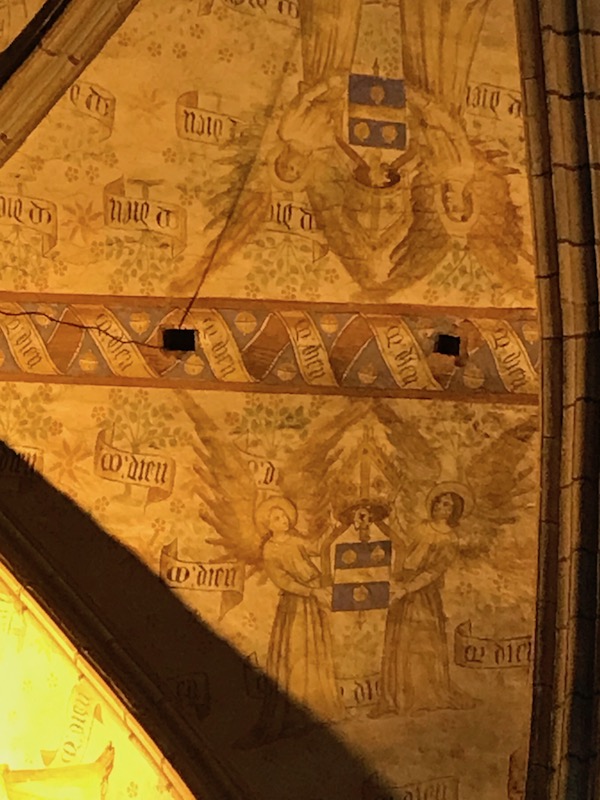
Then we went by the Lenn ar Gloar fountain. "Gloar" means "Glory" in the Breton language. It was originally named after Saint Paul, the first bishop, who blessed it when he arrived. It has a niche with a 16th century statue of the Virgin and Child. The water from the fountain supposedly has healing powers with people being "cured" after pouring the water on themselves.
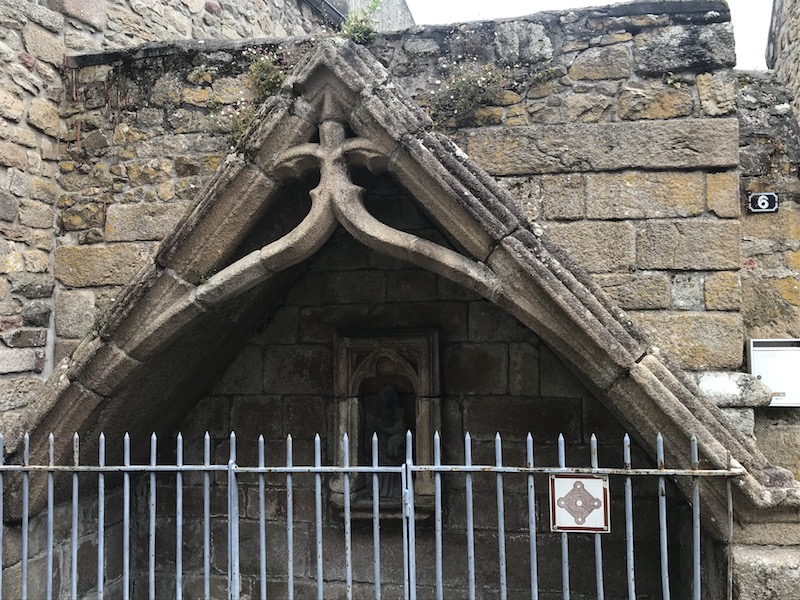
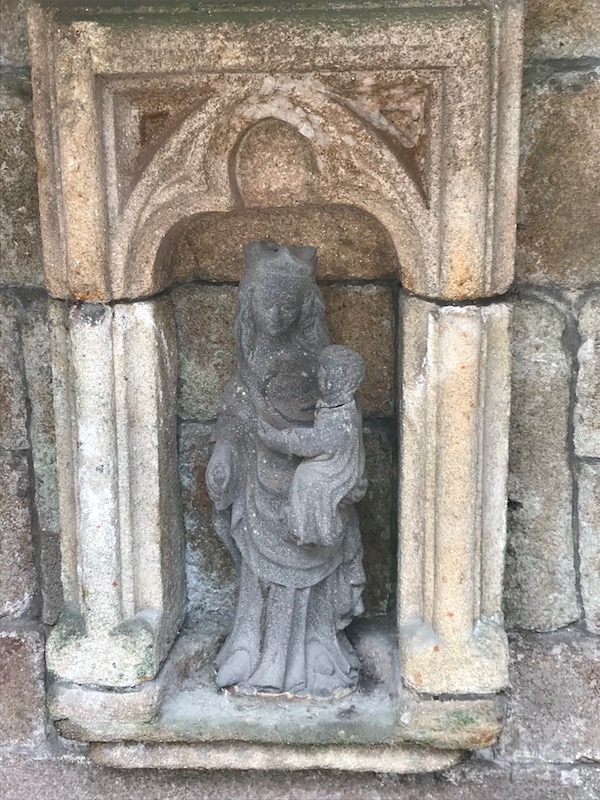
The other church that we saw in town was Notre-Dame du Kreisker chapel, which has the highest church tower in Brittany (78 meters tall). The origins go back to the 6th century with the legend of a young maiden who became completely paralyzed after worked on a holiday, despite the disapproval of Saint Kirec. After her repentance, the Saint healed her and she gave him her house to be converted into a chapel. This chapel was called Kreis-Ker. This chapel (most likely made of wood), was destroyed and rebuilt in the 14th century.
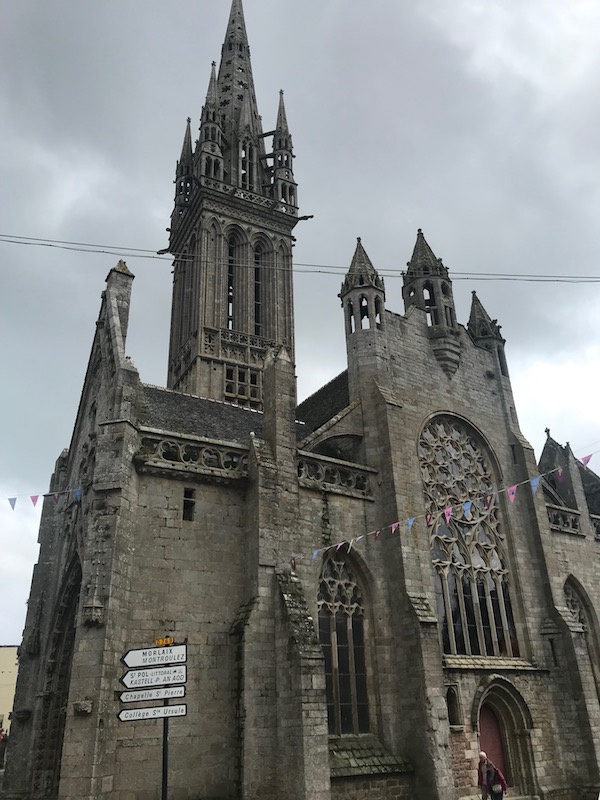
Here you can see the narrow nave with the Gothic arches that separate it from the side aisles.
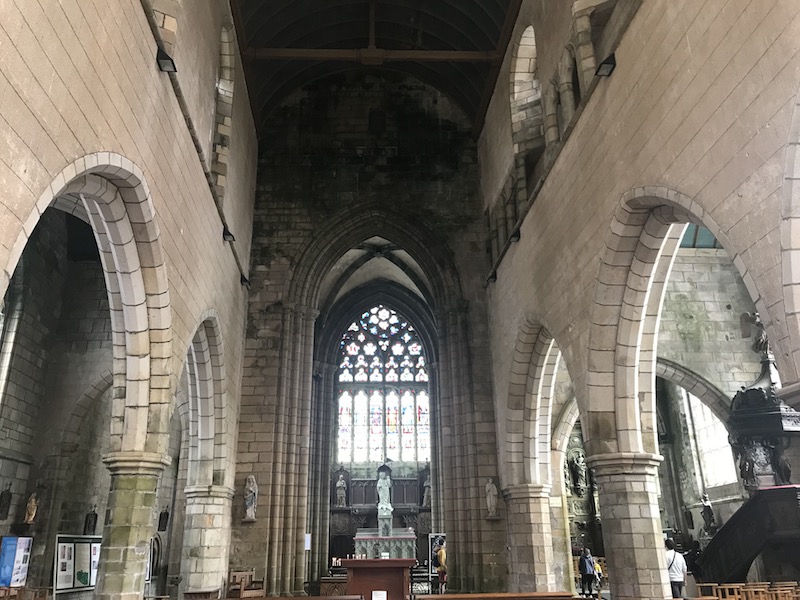

This altar, created in 1864, called the Altar of the Visitation. It was not originally in this church but was moved here after the French Revolution from the Convent of the Minimes. There are 4 twisted columns with a panting of the visitation in the middle. The detailed status i that of Sainte Marguerite (on the right-hand side of the altar).
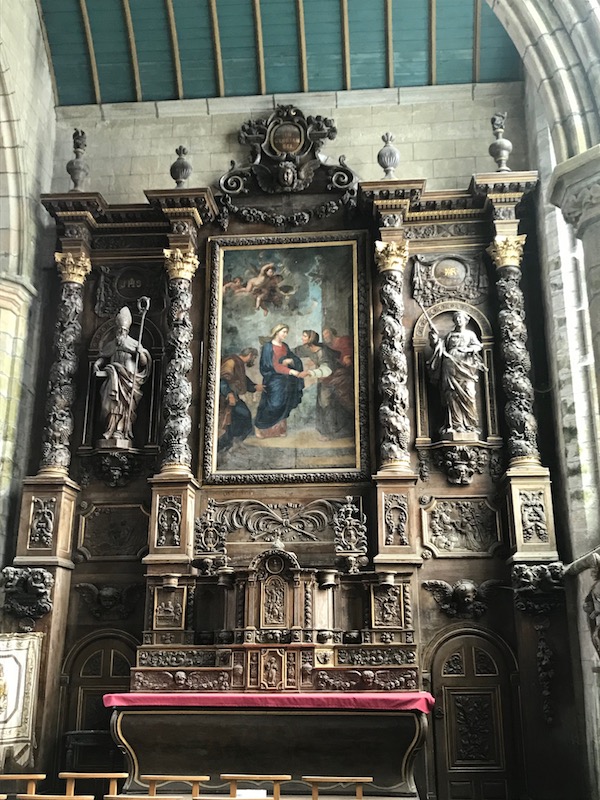
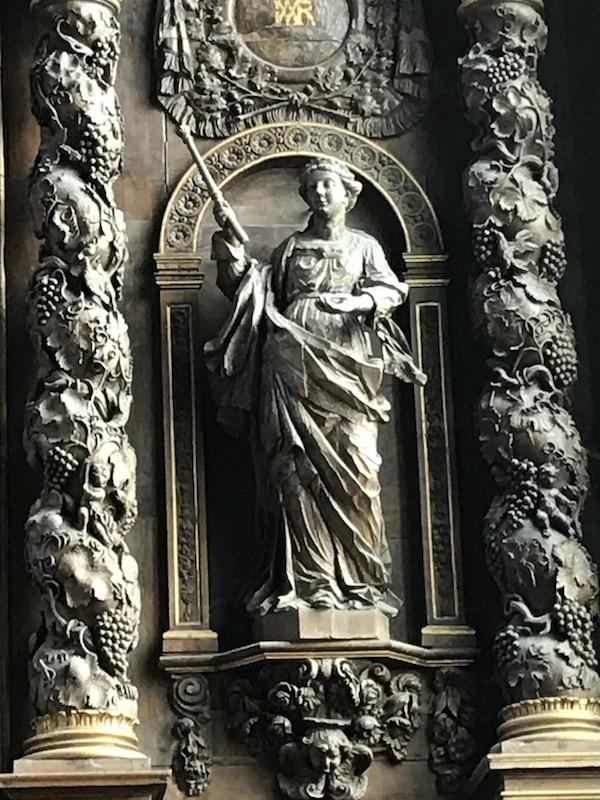
This was an interesting model of the church, which shows the relatively low ceilings and then the very tall spire in the middle. If you look at a couple of the pictures above, you can actually see the inverted-boat-bottom ceilings on the side aisles (the green-painted wood).
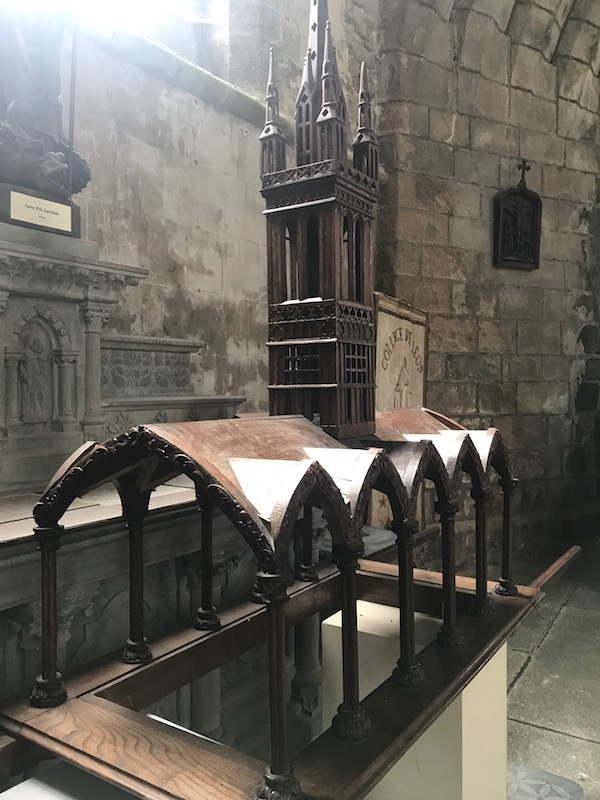
This window had quite a bit of detail written, so I will try to do a semi-good translation from the French. They were done in 1954 by Auguste Lambouret. Here is the full window:
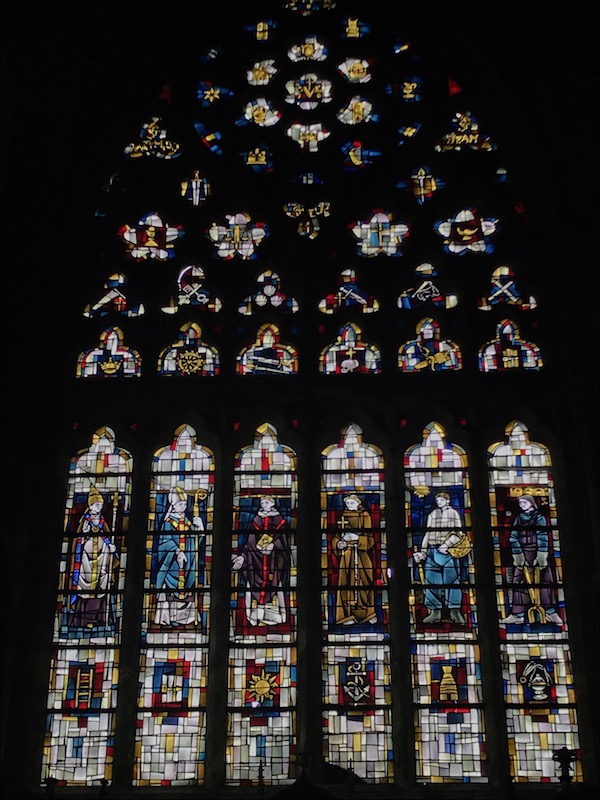
Now the details ... this window is in a chapel dedicated to the Virgin Mary, and so in the very center of the rose window, you can see the monogram of Mary (the M). You can also make out the names of the 4 evangelists: St Marc (Mark), St Mathieu (Matthew), and St Jean (John) ... Saint Luke got cut off on the bottom.

At this level, there are details that are related to Apostles or martyrs, including keys, a book, the shell of Saint-Jacques, a cross, a skull, etc.
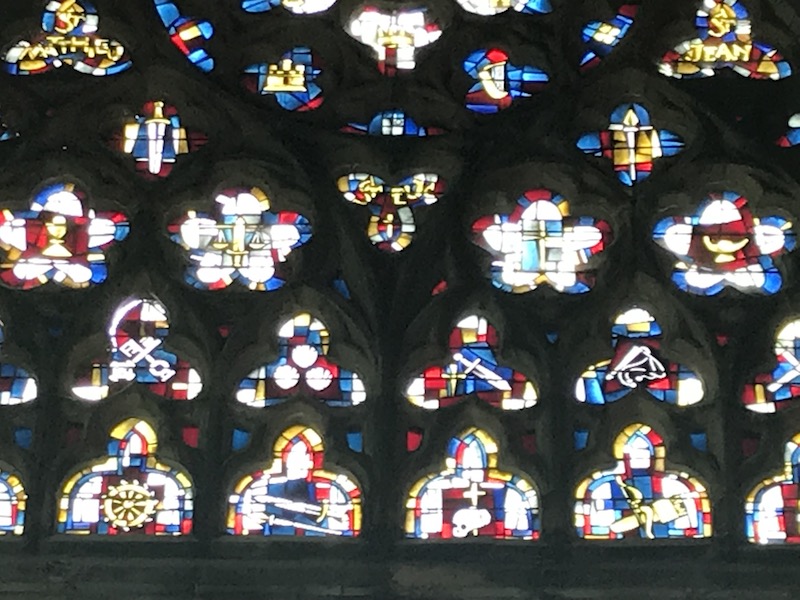
These next two show 6 types of people who would come to pray here, including a pope, a bishop, a priest, a monk, a laborer, and an artist. Below the people are additional symbols, such as a sun (indicating zeal), a ladder (indicating prayer), an anchor (faith), thorns (patience), a beehive (work), a book (the word of God).
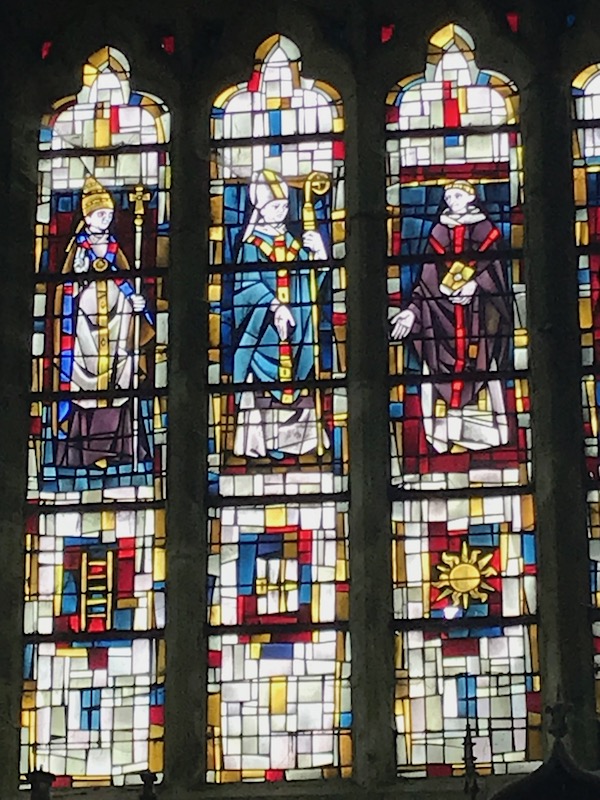

This is the rose window in the West gable, and it was created in 2014 by a Korean artist named Kim En Joong. These contemporary stained-glass windows are underlined by a symbolism of colors: red for the Holy Spirit, yellow for joy, and blue for purity.

One of the more interesting Monuments aux Morts (monuments to our dead). This one was inside the church and showed a soldier who seems to be either dead or dying in a laying-down position. It was sculpted in 1929.

